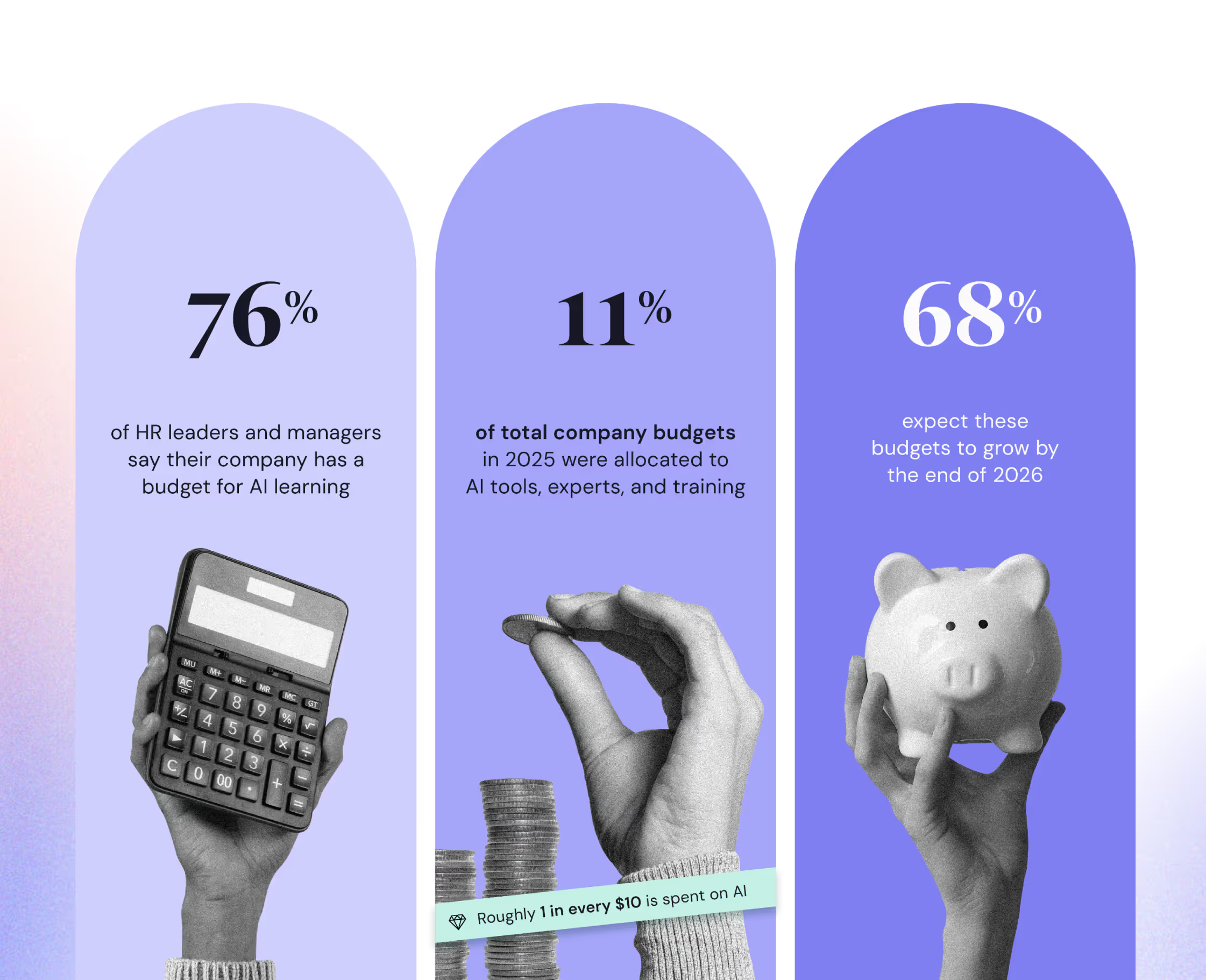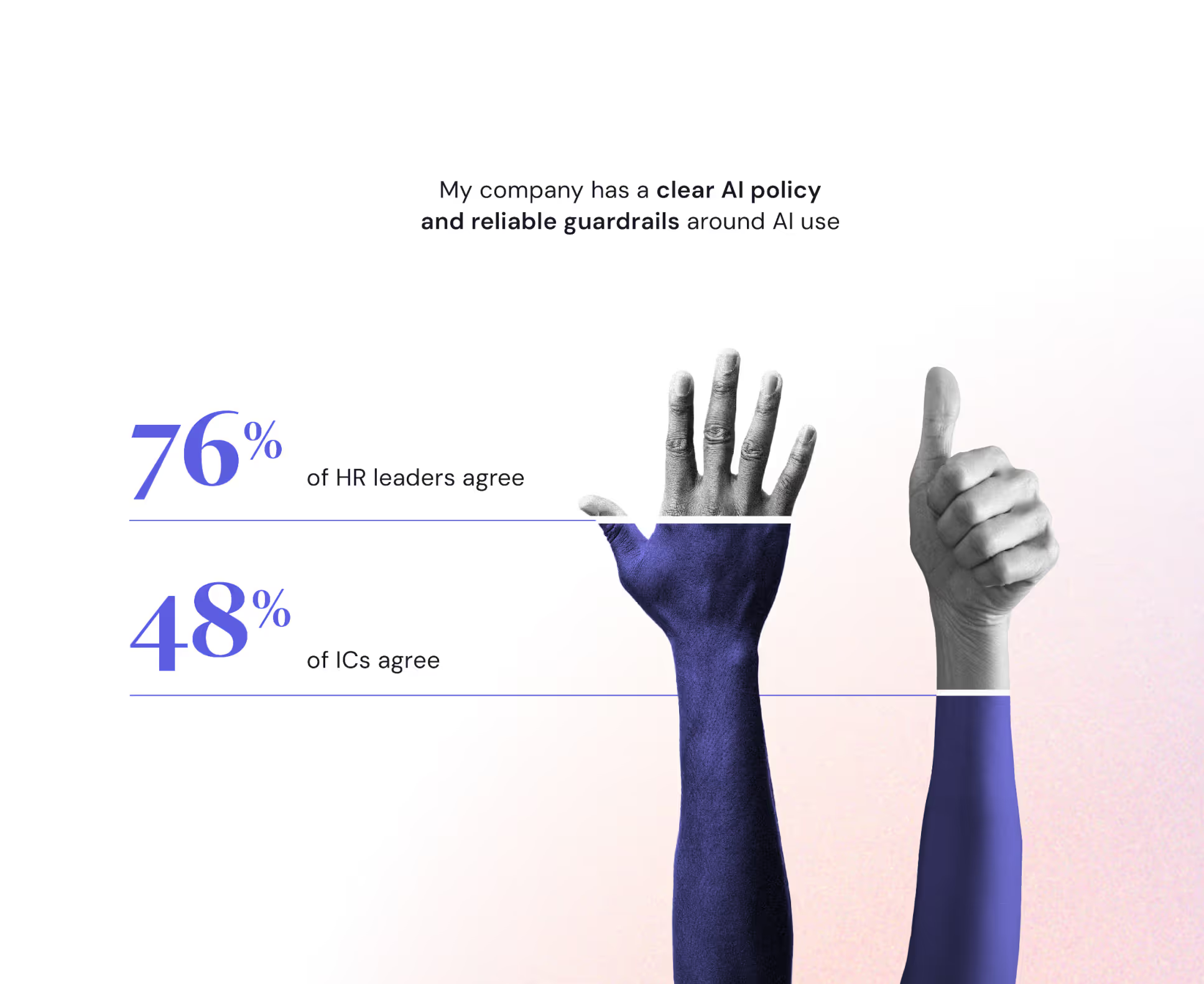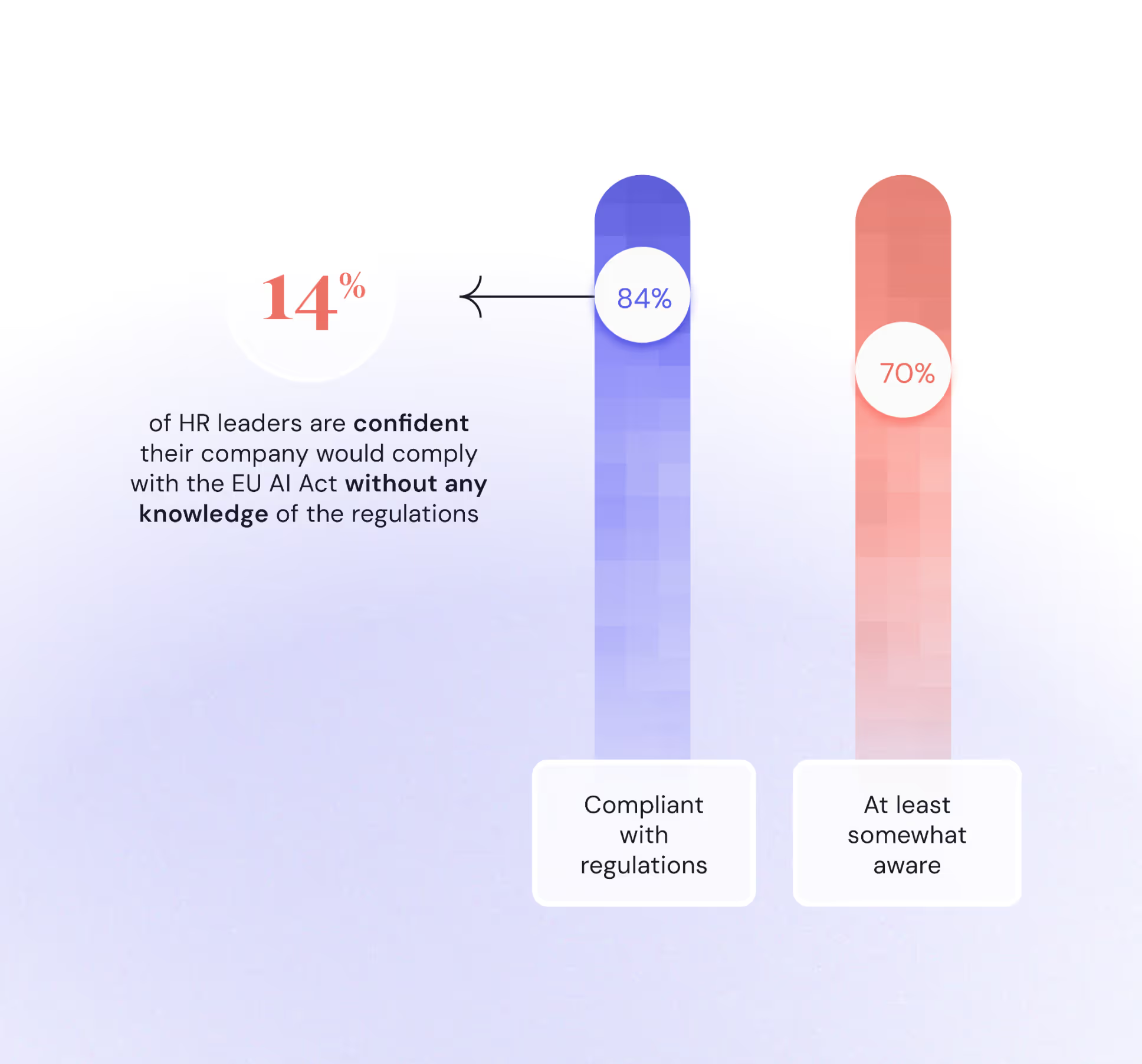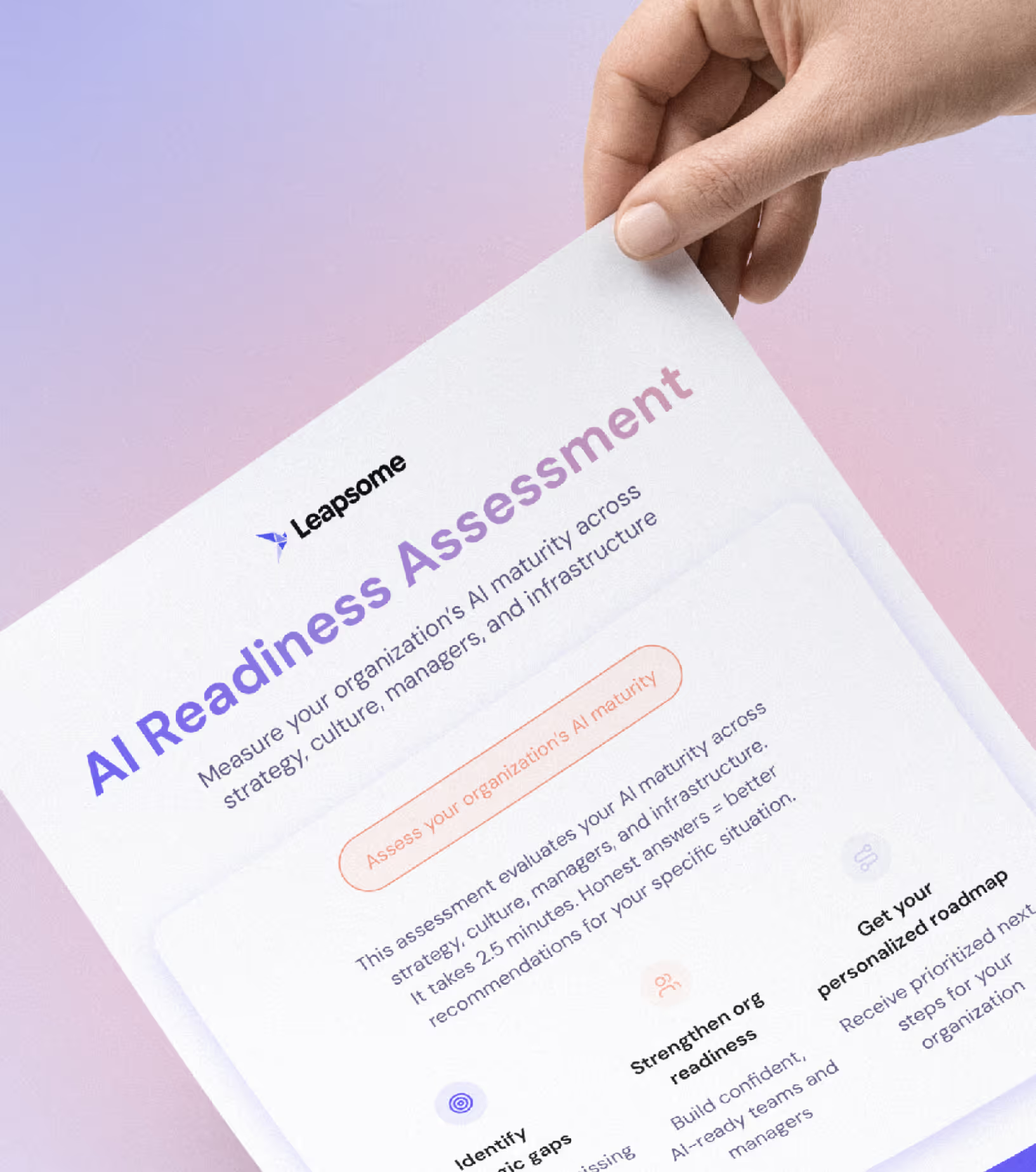Trend 3
2026WORKFORCE
TRENDS REPORT



AI can be a growth story, if you build for it
AI doesn’t have to be a threat. It can create new career paths, spark innovation, and help people build long-term security by developing new skills — but only if companies give employees the clarity, tools, and ownership they need to grow with it.
Most organizations aren’t there yet. Adoption is rising and HR leaders are already seeing new roles emerge, but the challenge is turning early progress into lasting growth.






Employees are narrowing the AI use gap with leaders
Daily AI use is increasing across roles. Leaders remain the most consistent users, but employees are quickly catching up — a sign people are ready to adapt as AI becomes part of daily work.
Still, adoption alone won’t close the skills gap. Without clear guidance on how to apply AI, benefits remain uneven, and some employees risk falling behind.
For adoption to mean progress, employees need clear guidance and support alongside the tools.






HR & employees divided on AI’s career impact
AI literacy is influencing who gets hired and promoted. HR leaders say AI skills now weigh heavily in decisions, but most employees don’t yet see them as essential for advancement.
This perception gap risks slowing adoption and creating missed opportunities for growth.
If AI knowledge is becoming a hiring standard, the smarter move is to invest in upskilling the people you already have. It’s not only more cost-effective than replacing talent, but also builds loyalty and fairness — ensuring progress benefits everyone.






AI training isn’t landing with employees
Companies are investing into AI learning, but many employees say the basics still aren’t showing up in daily work. Leaders report that time, guidance, and strategies exist, yet individual contributors experience far less support in practice.
When training feels disconnected from real roles, adoption slows. Employees want to know how AI applies to their work, why it matters, and how to use it effectively.
Without clarity, even well-funded programs risk becoming check‑the‑box efforts that widen the skills gap instead of closing it.






Who owns AI training?
Part of the challenge is unclear ownership. Most respondents point to IT as the team responsible for AI training. However, IT typically focuses on tools and security, not adoption or day‑to‑day learning.
That’s where HR comes in.
HR’s role is to bridge implementation and enablement — ensuring technical rollouts translate into clear guidance, accessible learning, and confident adoption. Without this balance, training stays fragmented and progress slows.






There’s a confidence gap about AI training
Regardless of their involvement, most HR leaders are confident their companies will deliver the AI training people need. Employees aren’t so sure.
38% of individual contributors aren’t convinced their company will provide the specific training they need. Without follow-through, even well-designed programs risk being seen as empty promises.






Budgets for AI learning are growing
Companies are dedicating more and more resources to AI upskilling, but money alone doesn’t build trust.
What matters more is whether that spend translates into real learning and impact for employees.






AI adoption needs both skills and clear rules
And impact isn’t just about training budgets. Employees also need clear skills development and rules they can trust in daily work.
Many HR leaders say those policies are already in place, but most employees don’t know such guardrails exist or don’t understand them.
This lack of visibility leaves people second-guessing how and when to use AI, applying it inconsistently, and missing opportunities to make it genuinely useful.






HR feels confident about AI compliance —even without the facts
Compliance is part of the guardrails conversation, but knowledge gaps remain. One in four HR leaders admit they don’t understand key regulations like the EU AI Act, and some have never heard of it. Despite this, most still express confidence their company would be ready if the Act took effect tomorrow.
Such a disconnect at the leadership level is risky. It leaves organizations open to compliance breaches, reputational harm, and strategic missteps as AI becomes more regulated.






Clarity turns AI pressure into progress
HR-supported rollouts, visible rules, and well‑designed training shift the perception of AI from a source of stress into a source of value.
When AI upskilling is done well, it builds knowledge and confidence. Employees see a clear path to grow, stay engaged in their roles, and recognize that the company is invested in their future.
With clear expectations and accessible support, AI adoption feels safe and delivers results.





Turn insights into action
Make AI easier to adopt by giving people ownership, role-based skills, and visible value.
Name the owner
Assign responsibility for AI upskilling and adoption; HR leads enablement, IT secures tools, and managers model everyday use.
Make rules visible
Publish plain-language guardrails with examples; open “safe to ask” channels and office hours.
Show the value
Translate training into role-based use cases; time-box pilots; enlist early adopters as peer coaches and share wins.




AI moves fast.
Human leadership keeps pace.
AI is racing ahead, faster than most organizations can keep up with. The ambition is huge, but without the right support, employees feel overwhelmed, leaders lose trust, and innovation slows.
The technology isn’t the risk. What puts organizations at risk is leaving people behind — missing the chance to use AI to free them from busywork so they can do what only humans can: lead, create, and connect.
The solution isn’t always another platform or dashboard. It’s leadership.
Platforms and dashboards have their place, but real progress depends on leadership. The Candor, Courage & Care™ model is designed to guide that.
Candor (the what): Name what’s real. Use AI-driven insights to tell the truth with clarity and context so teams know what matters most.
Courage (the when): Step in at the critical moments. Decide when to act, when to speak up, and when to push back on bias — whether it comes from people or from the technology.
Care (the why): Lead with presence and purpose. Show why people matter more than platforms, building trust and belonging as the foundation for growth.
When leaders bring Candor, Courage & Care™, AI shifts from overwhelming to empowering. It fuels productivity, while human leadership ensures trust, resilience, and innovation.
The future of work isn’t machine vs. human. It’s machine + human. AI accelerates. Candor, Courage & Care™ keeps it human.





From fear to flow
As current approaches to AI adoption foster cultures of fear, these 10 Truths of Radiant Change offer a simple framework for finding flow.
Change is…
Inevitable. Recognize AI’s benefits and risks, and that it’s here to stay.
Possible. Envision a future of AI-enabled work — teams with time to think, enhanced creativity, accelerated advancement — and share this vision widely.
Complex. AI isn’t a silver bullet or a quick fix. It demands strategic alignment, training, workflow redesign, and cultural adaptation.
Uncomfortable. Engage early and often, with empathy. Honor fears before trying to build excitement about emerging opportunities.
Intentional. Stop performing certainty at the leadership level; model curiosity and a growth mindset instead.
Personal. Every AI conversation builds or breaks trust. Use disagreements to sharpen perspectives and shape better solutions.
Fractal. Build momentum with early adopters rather than mandating uniform adoption. Peer superusers can be more influential than executives.
Inclusive. The best ideas come from those closest to the work. Co‑create AI strategy with actual users, not assumptions.
Iterative. Create feedback loops capturing both successes and failures. Encourage AI experimentation, sharing what works and what doesn’t.
Infinite. Celebrate progress over perfection, building organizations that continuously evolve with emerging technologies.
The organizations that thrive in the AI era will be those that pair artificial intelligence with human insight — multiplying the power of both.
Instead of defaulting to unrealistic expectations, inadequate support, and eroding trust, leaders have the choice to create a different path forward.





AI Readiness Assessment
Preparing your workforce for AI adoption takes more than technology — it demands strategy, culture, and confident leaders.
In just 2.5 minutes, this assessment will measure your organization’s AI maturity and uncover how to close your specific gaps.
What’s inside
- A quick quiz to assess strategy, culture, managers, and infrastructure
- Instant results showing your organization’s AI maturity level
- Personalized roadmap with prioritized next steps
- Recommendations to strengthen adoption and reduce risks






AI Upskilling Guide
AI isn’t replacing your people, but without the right skills, the gap between tools and outcomes will hold them back.
In just a few steps, this AI upskilling guide equips your teams with the confidence and know-how to work smarter, faster, and more responsibly.
What’s inside
- The core technical, role-specific, and soft skills to prioritize
- A 5-step framework to build a scalable upskilling program
- Practical examples and quick wins to strengthen adoption






Build the skills your workforce needs to thrive
Leapsome’s learning and development module gives employees access to the right training at the right time, so they can grow with AI — not get left behind.





Trend 4:
Rebuilding trust in HR




-compressed.avif)
